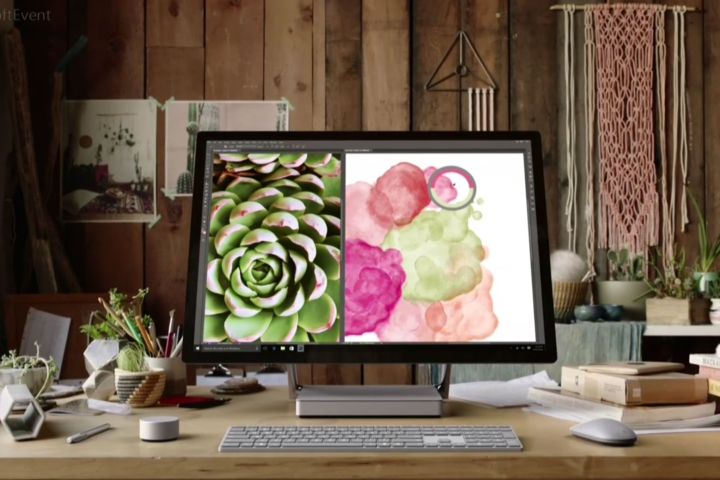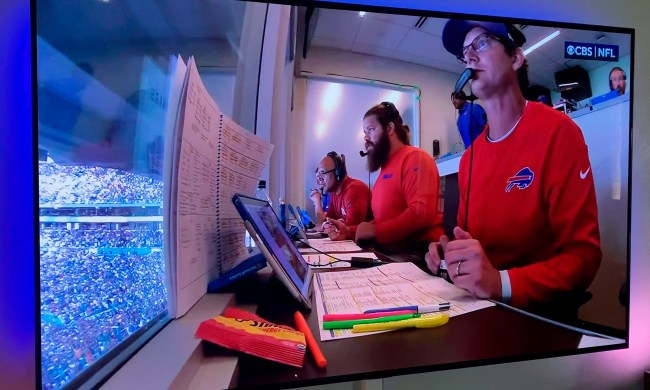
Specs
|
Surface Studio 
|
XPS 27 all-in-one  |
|
| Display & Dimensions | 28-inch PixelSense touch | 27-inch IPS LED touch |
| Processor | 6th-gen Core i5 or i7 | 4th Generation Intel Core i5 or i7 |
| Operating System | Windows 10 Pro | Windows 10 Home |
| GPU | Nvidia GeForce GTX 965M 2GB or 980M 4GB | Intel HD Graphics without TPM or 2GB Nvidia GeForce GT750M |
| RAM | 8GB, 16GB, or 32GB | 8GB, 1600MHz, DDR3 up to 16GB |
| Hard drive | 1TB or 2TB hard drive | 2TB 7200 rpm SATA 6Gb/s Hard Drive + 64GB mSATA Solid State Drive |
| Ports | USB 3.0 (x4), Mini Displayport, ethernet, SD card reader | USB 3.0 (x6), HDMI, gigabit ethernet, 8-in-1 card reader |
| Wireless | 802.11ac Wi-Fi, Bluetooth 4.0, Xbox Wireless built-in | 802.11ac, Bluetooth 4.0 |
| Cameras | 5.0MP front-facing 1080p with Windows Hello support | Intel RealSense Camera with Windows Hello support |
| Speakers | Stereo 2.1 with Dolby Audio Premium | Waves Maxx Audio |
| Microphones | Dual microphones | Dual microphones |
| Price | $2,999 | $2,299 |
| Availability |
Microsoft |
Dell |
| DT review | 4.5 out of 5 stars |
The Surface Studio can be equipped with up to a Core i7 quad-core processor and the Nvidia GTX 980M GPU. These performance specs may not necessarily jump off the page, however, when compared to the 4th-gen Intel Core i5 or i7 processor and a 2GB Nvidia GeForce GT750M in the XPS 27, the Surface Studio exists in a separate tier all together. The Surface Studio also touts superior RAM — 32GB opposed to the maximum 16GB in the XPS 27. The Surface Studio is a more capable machine when it comes to performance, even if it’s still utilizing last-gen hardware. Graphic designers and other creative types should have little trouble with their projects.
Display

The new Surface Studio incorporates a crisp, 28-inch Pixel Sense touch display. With 4,500 x 3,000-pixel resolution and 192 pixels per inch, images should be more vivid and vibrant than anything on the XPS 27. The smaller, 27-inch IPS LED touch display on the latter machine touts a mere 2,560 x 1,440-pixel resolution and 109 ppi, which makes it look dated in comparison. Moreover, the Surface Studio can also instantly switch colors spaces with a simple toggle in the notification pane, something that will surely appeal to photographers and graphic artists alike. The XPS 27 offers no such feature.
Design

The Surface Studio uses an innovative “Zero Gravity Hinge,” allowing users to effortlessly switch the device from the upright Desktop Mode into a Studio Mode that renders the device nearly flat. When positioned in Studio Mode, the device locks into place at a 20-degree angle for a more natural, hands-on drafting experience. This allows designers to use the Surface Pen and the new Surface Dial more organically. That brings us to one of the key features of the Surface Studio unveiling: the Surface Dial.
The Surface Dial looks like a a rather innocuous matte puck. However, the tool is actually a touch-sensitive wireless dial you can place on your display or desk, letting you scroll through and adjust an amalgam of settings with a simple rotation. In preliminary demos, Microsoft showcased the ability to use the Surface Dial directly on the screen in conjunction with several design apps, which allowed the user to tweak color palettes, line thickness, a host of other image facets.
With a thick, boxy exterior and hulking plastic accents, the overall design of the XPS 27 is less to behold than that of the Surface Studio. Similarly, the XPS 27 may be less useful to graphic designers than the Surface Studio, but the XPS 27 is still quite capable for other tasks. There’s no sexy hinge, nor will you be able to “dial-in” so to speak, but the XPS 27 still utilizes the touch-enabled display to its advantage.
Availability and pricing
The base-model of the Surface Studio starts at $2,999, and comes with a Core i5 processor, GTX 965M, 8GB RAM, and a 1TB hard drive. An additional $500 will allow you to upgrade to a Core i7 CPU and 16GB of RAM.
The top-of -the-line model includes a GTX 980M, 32GB RAM, and a 2TB hard drive for $4,199. You can pre-order the Surface Studio now, but it won’t ship until December 15.
With the XPS 27, a modest $2,299 will net you the top-of-the-line Dell XPS 27 Touch model, which comes with a 4th-gen i7 processor, 16GB of RAM, and a 2TB hard drive for $2,299.
Conclusion

Until the unveiling of the Surface Studio, Microsoft had decided to only focus its “Surface” revolution on tablet options. The Surface Studio, however, looks to merge the desktop with the company’s existing lineup of Surface products. We could be looking at an epic clash of titans down the road as Microsoft appears to take aim at the iMac with this unique, desktop conversion.
When it comes to the comparison between the Surface Studio and the XPS 27, though, it’s almost more of a juxtaposition rather than a fair technological comparison. The Surface Studio is simply a more versatile, powerful product, one that showcases a sleek, modern design that’s nothing short of gorgeous. The Dell XPS 27 is less expensive, sure, but it’s nowhere near as capable.


